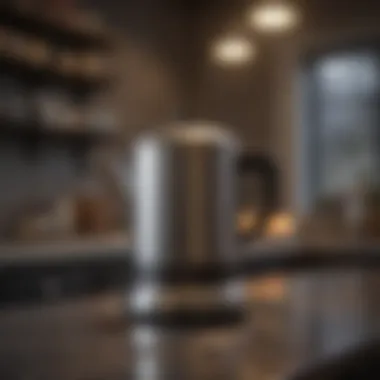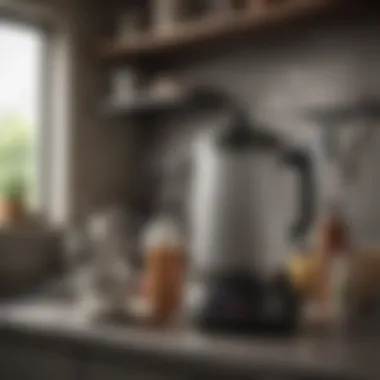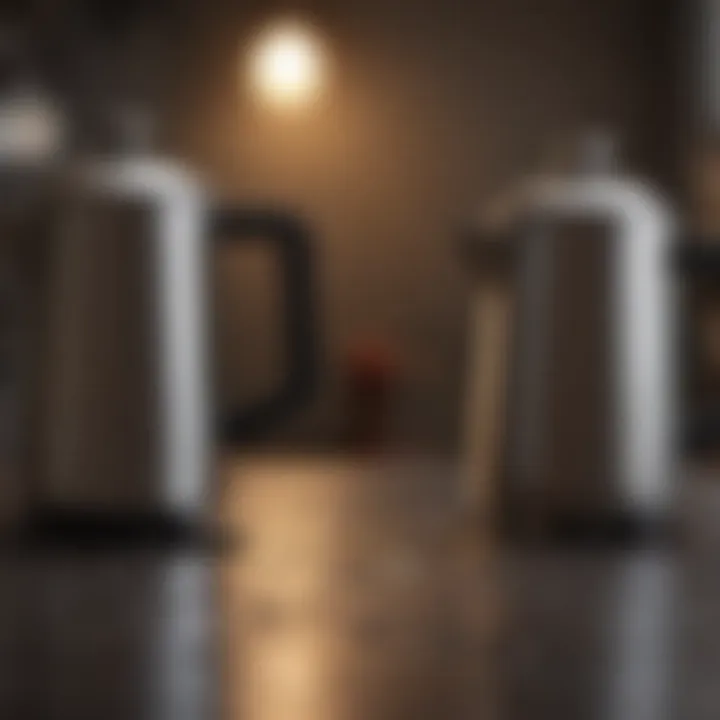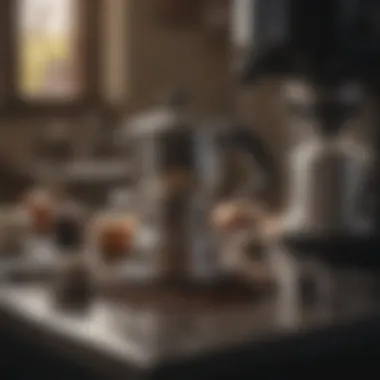Essential Tips for Cleaning Your Coffee Percolator


Intro
Keeping your coffee percolator clean is crucial if you want to enjoy that rich, bold flavor cup after cup. Over time, mineral deposits, oils, and residue build up, which can affect both the taste of your coffee and the lifespan of your beloved percolator. You might think washing it out with soap and water suffices, but let me tell you, it’s a bit more involved than that.
This guide is designed to take you through the essential steps and methods for effectively cleaning your coffee percolator. We’ll cover everything from the tools you'll need to the actual cleaning techniques for different types of percolators, ensuring that your daily brew remains as delightful as the first sip of your caffeine-fueled mornings.
Relevance of the Topic
As coffee enthusiasts, we often overlook the importance of maintaining our brewing equipment. Neglecting to clean your percolator not only alters your coffee's flavor profile but can also lead to premature wear and tear of the machine. This guide provides insight for both novices and seasoned baristas, aiming to enhance your coffee-drinking experience and ensure that your percolator remains a dependable companion in your kitchen arsenal.
While you might be tempted to skip a few steps, diving deep into these cleaning methods can pay off immensely, both in taste and performance. So, grab your favorite mug and let’s explore the nitty-gritty of keeping your coffee percolator in top-notch condition.
Importance of Cleaning a Coffee Percolator
Keeping a coffee percolator in tip-top shape isn’t just about aesthetics. It directly impacts your brew and health too. The truth is, when you skip on cleaning, you might be letting the shadow of tarnished flavors creep into your cup. Let's dive into why putting time into maintaining your percolator is more than an afterthought.
Impact on Coffee Quality
When it comes to brewing coffee, the quality of your equipment plays a starring role. Over time, oils from the coffee grounds can build up inside the percolator, mingling with water and altering the purity of the taste. Imagine a brew that tastes like yesterday's fish fry – the rancid residue isn’t a pleasant mix with your morning ritual.
Not only that, but using a dirty percolator can also result in uneven brewing. The stuck debris acts like a wall, inhibiting water flow and preventing uniform extraction of those precious coffee beans. As you know, a well-extracted cup holds the key to flavor brilliance.
- Flavors Gone Awry: A recent study noted that consistently cleaning coffee equipment could enhance taste profiles by nearly 30%. Just think – you might not have to throw in the fancy beans to enjoy richer flavor!
- Consistency is Key: Practicing regular cleaning means you can rely on a consistently good cup without the gamble of remnants from old brews sneaking through.
Health Considerations
Let’s not sugarcoat it; a neglected coffee percolator can house a breeding ground for mold and bacteria. Every time you brew coffee, you might unknowingly introduce these unwelcome guests into your system. And nobody wants to wake up with more than coffee on the brain. It’s vital to ensure hygiene standards are met in the realm of beverage preparation.
- Potential Health Risks: A dirty percolator can lead to gastrointestinal issues. Though it sounds like a reach, bacteria from old coffee oils can cause upset stomachs – which is just plain unnecessary.
- A Clean Brew is a Healthy Brew: When maintaining a clean percolator, you minimize the risk of brewing molds and other contaminants. The payoff is that you can enjoy your cup with peace of mind.
In summary, regular cleaning serves as a cornerstone for great coffee quality and your health. Simple ways to prevent poor health outcomes and bad taste include setting a routine cleaning schedule and being proactive about the upkeep of your percolator. So, rolling up your sleeves and scrubbing that machine might just be the best decision you've made for your daily cup of joe.
Understanding Coffee Percolators
If we want our coffee to sing with flavor and bring us comfort with each sip, we have to start with understanding the heart of the brewing process—the percolator. Knowing how these machines operate, their nuances, and what options are out there can drastically affect both the quality of coffee produced and the overall brewing experience. We'll explore the distinct types of coffee percolators, along with what makes each one tick. This clarity will help in maintaining your percolator and ultimately, crafting the ideal cup of joe.
Types of Coffee Percolators
When it comes to brewing coffee, there are three primary types of percolators worth noting. Each of these has its unique traits and benefits that cater to different preferences.
Stovetop Percolators
Stovetop percolators are a timeless classic; many would argue they're the simplest yet most effective way to brew. Instead of electricity, they rely on the inherent warmth of your stovetop. This hands-on approach often results in a deeper connection between the brewer and the brew process.
One of the key characteristics of stovetop percolators is their efficiency. They can heat water quickly, which then cycles through the coffee grounds multiple times. What makes them a crowd favorite is their easy handling and relatively affordable price.
However, they do require a bit of skill. If you don’t keep an eye on things, the coffee can easily turn bitter due to prolonged brewing times. Still, for those who appreciate the nuances of brewing, stovetop percolators provide an invaluable experience in coffee-making.
Electric Percolators
On the other hand, electric percolators offer a level of convenience that's hard to match. With built-in heating elements, they allow you to brew without the need for a stovetop, making them a popular choice for many modern kitchens. The consistent temperature control helps ensure that coffee is brewed evenly.
Electric percolators often come equipped with timers and automatic shut-off features. This means you can set it and forget it, freeing you up for other tasks while your coffee brews. However, this convenience can sometimes come at the cost of flavor complexity, as they may not achieve the same depth as manual brewing methods, depending on the model.
Vacuum Percolators
Vacuum percolators take coffee brewing to an entirely different level of experimentation. They rely on a fascinating principle of physics: vapor pressure to produce a unique brew. The water vapor forces the boiling water up into the coffee chamber, creating a vacuum effect to pull the brew back down after steeping.
The standout feature of vacuum percolators is the theatrical brewing motion they create. Not only does this method look stunning, but it also generally results in a clean and flavorful cup of coffee. They are often made of glass and can become a true showpiece in your kitchen.
Though, it’s worth mentioning that vacuum percolators may require more cleanup and can be delicate, which makes some opt for more straightforward methods.
How Percolators Work
At the crux of brewing coffee with a percolator, the process revolves around the extraction of flavor from the coffee grounds. The percolator’s design ensures that hot water cycles through the coffee grounds, fostering optimal extraction of essential oils and flavor compounds.
A typical percolator consists of three main parts: the water chamber, the coffee basket, and the stem. Water is heated in the water chamber, then rises through the stem and saturates the coffee grounds in the basket. Gravity pulls the brewed liquid back down into the water chamber, and the cycle continues until the desired strength is reached. The magic lies in how this process can be monitored and adjusted based on individual taste preferences.
By understanding the mechanics and types of coffee percolators available, you can make informed decisions about which one suits your brewing style and cleaning requirements. A well-chosen percolator and proper maintenance can keep your coffee tasting fresh and delightful for years to come.
Essential Cleaning Supplies
When it comes to cleaning your coffee percolator, having the right supplies is half the battle won. The importance of selecting effective cleaning agents cannot be overstated. Not only does it enhance the lifespan of the appliance, but it also keeps the flavor of your favorite brew intact. In this guide, we delve into the essential cleaning supplies you’ll need to maintain the integrity of your coffee percolator.
Basic Cleaning Items
Dish Soap
Dish soap is often the go-to for many in household cleaning, and for good reason. It’s specially formulated to break down oils and grime. In the context of a coffee percolator, this makes it an indispensable ally.
One of the best traits of dish soap is its ability to effectively handle the residual oils that coffee can leave behind. It’s not just about removing the stains; it’s also about ensuring that your next cup doesn't carry the lingering aftertaste of yesterday’s brew. The gentle yet effective nature of dish soap is particularly advantageous because it won’t scratch or harm the surfaces of your percolator. Just remember, using too much can lead to excessive suds, which can create a bit of a fuss during rinsing.
Vinegar
When it comes to natural cleaning agents, vinegar reigns supreme. Its acidic properties make it exceptionally good at cutting through mineral deposits and coffee build-up. Regular use of vinegar as part of your cleaning routine helps prevent the percolator from tasting stale over time.


One distinctive feature of vinegar is its deodorizing effect. Not only does it help eliminate bad odors, but it also leaves behind a fresh scent. Vinegar is a heavyweight champion in terms of cost-effectiveness, making it a popular choice among coffee lovers. Be cautious, however, as too much vinegar might leave a lingering taste if not thoroughly rinsed.
Baking Soda
Baking soda is often hailed as a versatile cleaning agent, and rightly so. Its mild abrasive nature makes it an ideal candidate for tackling stubborn stains that more delicate cleaners might struggle with. It’s particularly useful for scrubbing issues where there’s a build-up of tough coffee residue.
A unique feature of baking soda is its ability to neutralize odors, much like vinegar does, but without the strong scent. This can be especially helpful in ensuring your percolator doesn’t retain any previous coffee flavors. Additionally, it tends to be safe for all types of materials, so you can use it with a bit more freedom. Keep in mind, though, that when used in wet environments, it can clump together, which might make even distribution a bit tricky.
Optional Tools
In addition to the basic cleaning agents, there are some tools that can significantly enhance your cleaning efforts.
Soft Cloths
For those who value a scratch-free finish, soft cloths are a must-have. Their plush texture provides a gentle touch without risking damage to any glass or metal surfaces. They’re best for wiping down the outer surfaces of your percolator, ensuring it looks as good as it brews.
A major advantage of using soft cloths is their ability to effectively remove fingerprints and splatters without the risk of streaking. They’re easy to wash and can be reused multiple times. However, ensure that you keep them clean, as dirty cloths can inadvertently leave grime behind.
Brushes
A brush can be a lifesaver when addressing the nooks and crannies that a cloth cannot reach. Whether it’s a soft-bristled toothbrush or a specialized cleaning brush, having one at hand allows for a more thorough clean, especially for stubborn areas.
The key characteristic that makes brushes so effective is their ability to reach those tricky spots. However, use caution; stiff-bristled brushes can scratch some materials, so it’s wise to opt for softer options.
Sponges
Finally, sponges are another excellent cleaning companion for your percolator. Their absorbent nature allows for the easy wiping away of spills and stains. Some sponges feature a non-abrasive side, ideal for cleaning sensitive surfaces, while the scouring side can deal with tougher grime.
Sponges are often readily available and versatile, making them a common choice for many home cleaning tasks. However, they can harbor bacteria if not cleaned properly, so make sure to keep them sanitized for your percolator's safety.
Having the right cleaning supplies is integral to maintaining the functionality of your coffee percolator. Using these supplies not only promotes cleanliness but also enhances your coffee experience. Equip yourself with these tools, and your percolator will continue to serve a delightful brew for years to come.
Step-by-Step Cleaning Process for Stovetop Percolators
Cleaning a stovetop coffee percolator is not just about keeping up appearances. It’s an essential task that ensures your coffee tastes as it should—fresh and flavorful. Over time, oils and residue from coffee can build up in the percolator, leading to off-tasting brews. Thus, a systematic approach to cleaning your percolator is necessary to safeguard the integrity and taste of your coffee.
Disassembly of the Percolator
First things first, before getting into the nitty-gritty, disassembly is a critical step. It may seem a bit tedious, but it’s the only way to get to the spots that need the most attention. Start by ensuring your percolator is cool to the touch—don’t want to roast your hands! Carefully take off the lid, then the filter basket, and finally, remove the stem. Place all parts on a clean surface covered with a soft cloth to avoid any accidental damage. Keeping track of these components will make reassembly smoother, so perhaps lay them out in the order you disassemble them.
Removing Coffee Residue
Once you have everything disassembled, it’s time to tackle that pesky coffee residue. Stubborn stains can be a real beast, but don’t worry; you’re well-equipped for the battle. Use a soft cloth or sponge to wipe away any visible leftover coffee grounds or oils. For areas that look especially grimy, consider a paste made from baking soda and a bit of water. Apply this paste to those stubborn spots and let it sit for a few minutes. The baking soda works wonders, lifting grime without scratching your precious percolator.
Washing Components
Now that you've tackled the tough stuff, let’s move to the washing phase. Grab yourself some mild dish soap and warm water; nobody needs harsh chemicals here. Use a non-abrasive sponge and gently wash all components of the percolator. Pay attention to the inside of the carafe and filter basket, as these areas often harbor stubborn oils. For the metal parts, a thorough rinse is crucial. Any residual soap can alter the flavor of your coffee later on. Just a little rinse under warm running water should do the trick. For added assurance, why not run a clean, damp cloth through the percolator’s stem?
Reassembling the Percolator
As you get to the end of your cleaning journey, it’s time to put all those pieces back together. Before reassembling, ensure everything is completely dry. Water left in the crevices might lead to unsavory flavors in your next pot. Start with the stem, then the filter basket, and finally, cap it off with the lid. Give it a gentle twist to make sure everything fits snugly. Once you’ve reassembled your percolator, you might want to run a pot of plain water through it just to be certain there’s nothing left behind.
"A well-maintained coffee percolator is your best friend in achieving that cherished cup of coffee every time."
By following these steps, you’ll not only ensure your stovetop percolator is clean but also help prolong its life, keeping it in top shape for years of brewing enjoyment.
Cleaning Electric Percolators
Cleaning electric percolators is crucial in maintaining their performance and ensuring the brew remains fresh and delicious. Unlike stovetop percolators, electric versions have additional components like heating elements and electronic controls that can accumulate residue from coffee oils over time. If left unchecked, these residues can not only taint the flavor of your coffee but also lead to malfunctions or reduced lifespan of the machine. By understanding the step-by-step cleaning process, you ensure not only the quality of your coffee but also prolong the life of your appliance.
Preparing for Cleaning
Before diving into the cleaning process, it’s essential to make sure you have everything at your fingertips. Gather the necessary cleaning supplies and tools for an effective clean. Here’s what you’ll need:
- Dish soap: For general cleaning purposes.
- White vinegar: A natural descaler and deodorizer.
- Baking soda: Great for tackling stubborn stains.
- Soft cloth: For a gentle wipe down of surfaces.
- Water: To dilute and rinse products.
Prepare the electric percolator by unplugging it and letting it cool down completely. This step is critical; you don’t want to get burnt or cause any damage to components while cleaning. Once cooled, check the user manual for any specific instructions, as each brand might have particular requirements for cleaning.
Descaling the Heating Element
The heating element in an electric percolator is essential for the brewing process, but it’s also a hotspot for mineral buildup, especially if you have hard water. Regular descaling helps keep it functioning effectively. Here’s how to do it:
- Mix vinegar and water: Combine equal parts of white vinegar and water in the carafe. This solution helps dissolve any mineral deposits.
- Fill the water chamber: Pour the vinegar mixture into the water chamber of the percolator.
- Turn it on: Plug it back in and let the percolator run for a complete brew cycle. This process allows the descaling solution to flow through the heating element.
- Empty and rinse: After the cycle, dispose of the vinegar solution and fill the chamber with fresh water. Run it again to rinse out any vinegar remains thoroughly.
Avoid using harsh chemicals that can damage the heating element and always check if vinegar is safe for your specific make and model.
Deep Cleaning the Carafe
The carafe collects oils and residues from the coffee. A clean carafe means better-tasting coffee. Here’s a simple approach to deep clean:
- Soak: Fill the carafe with warm water and a couple of drops of dish soap. Let it soak for about 15 minutes to loosen dirt and stains.
- Use baking soda: For tougher stains, sprinkle some baking soda inside and scrub gently with a soft cloth or sponge. The combination of baking soda and water acts as an excellent abrasive agent without scratching the surface.
- Rinse thoroughly: After cleaning, make sure to rinse the carafe multiple times with clean water to ensure that no soap or baking soda residue remains. This step is key because anything left behind could affect the taste of your coffee.
By taking the time to clean both the heating element and the carafe, you preserve the integrity of your coffee and guarantee satisfying brews every time. Keeping your electric percolator in tip-top shape not only ensures you enjoy a delightful cup of coffee but is also instrumental in maintaining the product's functionality over the long haul.
"Regular cleaning is not just about removing dirt; it’s about enhancing your entire coffee experience."
Maintaining Vacuum Percolators


Maintaining vacuum percolators requires special attention, primarily due to their unique construction and intricate brewing process. This method of coffee preparation firmly relies on both vacuum pressure and temperature control to achieve that smooth flavor and delightful aroma coffee aficionados cherish. Neglecting maintenance can lead to diminished coffee quality and even permanent damage to the device, making it essential to regularly tend to your vacuum percolator. Here are some key elements to consider:
- Preservation of Flavor: Residues, oils, and deposits can build up over time, creating off-flavors that can spoil your next cup. Keeping your vacuum percolator clean ensures that every batch of coffee tastes its best.
- Prolonging the Appliance’s Life: Regular maintenance minimizes wear and tear, ultimately extending your percolator's lifespan.
- Efficiency: A clean percolator operates more effectively, ensuring even heat distribution and optimal flavor extraction.
Disassembling the Vacuum Mechanism
The first step in maintaining your vacuum percolator is a careful disassembly of its components. This process may seem daunting, but following a systematic approach helps simplify the task.
- Gather Your Tools: You might need a small screwdriver, a soft cloth, and possibly some brush for cleaning certain areas.
- Cool Down: Ensure the unit is completely cooled. Attempting to dismantle a hot percolator is risky and may result in burns.
- Remove the Top Chamber: Gently twist or lift the top chamber off the base. There might be a few tight spots due to steam, so don’t rush.
- Take out the Filter: Carefully pull out the coffee filter. If it’s metal, inspect for any bends or blockages before setting it aside for washing.
By being gentle during this process, you ensure all parts remain intact and functional when reassembling later.
Cleaning the Glass Chamber
The glass chamber is critical in a vacuum percolator and requires delicate care to avoid scratches or chips.
- Use Mild Detergents: Opt for a mixture of warm water and a few drops of mild dish soap. Avoid harsh abrasives that could scratch the glass.
- Gentle Scrubbing: Utilize soft cloths or sponges for cleaning to lift coffee stains or residue without damaging the surface.
- Rinse Well: After scrubbing, rinse thoroughly under warm water to ensure no soap remnants linger, as they can affect the flavor of your next brew.
To keep the glass chamber pristine, consider soaking it in a solution of 1:1 vinegar and water if stains persist. Letting it sit for about half an hour often eases the scrubbing.
"Regular maintenance isn’t just about preventing issues; it’s about ensuring every brew is a pleasant experience."
In sum, keeping a vacuum percolator in good shape goes a long way in capturing and preserving the essence of coffee. By disassembling carefully and cleaning the glass chamber with mindfulness, coffee lovers can enjoy flavorful brews time and time again.
Using Vinegar for Effective Cleaning
Cleaning your coffee percolator effectively might seem like a mundane task, yet it is crucial for both maintaining optimal coffee taste and prolonging the lifespan of the machine. Vinegar has emerged as a go-to solution for many coffee aficionados and everyday users alike. Its natural efficacy and affordability make it an ideal choice for achieving a clean and hygienic percolator. In this article, we will explore how utilizing vinegar can enhance your cleaning routine while delving into the specifics of the process and the numerous benefits it brings to coffee equipment maintenance.
Instructions for Vinegar Cleaning
Cleaning your coffee percolator with vinegar is a straightforward task. Below are the step-by-step instructions that will guide you to harness the powerful cleaning properties of vinegar:
- Preparation: Start by ensuring that the percolator is completely cool and unplugged. Doing this helps prevent any accidents or burns.
- Mixing the Solution: Combine equal parts of water and white vinegar. This mixture should fill the percolator’s water chamber to the designated capacity.
- Brewing Cycle: Plug in the coffee percolator and turn it on. Let the vinegar and water solution run through a brew cycle. This will help loosen any build-up inside the mechanism.
- Soaking: After the cycle completes, turn off the machine and let the vinegar solution sit in the percolator for about 15-30 minutes. This designated time allows the vinegar to work its magic.
- Rinsing: Dispose of the vinegar solution and rinse each part of the coffee maker thoroughly with warm water to remove any vinegar residue. A couple of rinses should do the trick.
- Final Brew: To remove any lingering vinegar smell, brew a fresh pot of plain water through the machine. You may want to repeat this process a second time, just to err on the side of caution.
Benefits of Vinegar in Coffee Equipment Maintenance
Vinegar is not just a cleaning staple in the kitchen; it also provides specific benefits when it comes to maintaining coffee equipment. Some of the primary advantages include:
- Natural Descaling: Vinegar's acidic nature breaks down mineral deposits which can build up over time, especially in areas with hard water. This descaling effect ensures the percolator continues to function smoothly.
- Removes Odors: Vinegar is known for neutralizing unpleasant smells. Using it in your percolator can effectively eliminate any lingering coffee odors that build up from regular usage.
- Non-toxic: Unlike many commercial cleaning products laden with chemicals, vinegar is safe and environmentally friendly. It offers peace of mind knowing that no harmful residues are left behind to interfere with your coffee.
- Cost-Effective: Vinegar is widely accessible and inexpensive, making it an economical option for frequent use in maintenance routines.
"Using vinegar for cleaning is like getting a two-for-one deal; you not only clean but also prolong the life of your machine."
Utilizing vinegar as part of your coffee percolator cleaning regimen is actionable, effective, and easy to follow. When integrated with regular cleaning habits, this simple ingredient can contribute significantly to the longevity of your coffee maker and the quality of your brews.
Baking Soda as a Cleaning Agent
Baking soda, or sodium bicarbonate, is often overlooked in the vast expanse of cleaning products. However, its versatility and effectiveness make it a real gem when it comes to maintaining your coffee percolator. The gentle yet robust properties of baking soda not only help in scrubbing surfaces but also serve as a natural deodorizer. This is crucial for coffee enthusiasts who pour their heart and soul into each brew, only to find that lingering odors detract from an otherwise perfect cup of coffee.
Using baking soda in your cleaning regimen brings a myriad of benefits. It's affordable, environmentally friendly, and non-toxic, making it a safe choice for households with pets or children. Its mildly abrasive nature allows it to lift away those stubborn coffee stains without scratching or damaging the surfaces of your percolator. These aspects highlight why baking soda deserves a dedicated spot in your cleaning toolkit.
Moreover, baking soda is a fantastic option for those who prefer DIY solutions over store-bought chemicals. By harnessing baking soda's power, you can achieve a level of cleanliness that keeps your coffee tasting fresh and delightful.
How to Use Baking Soda
Using baking soda for cleaning your coffee percolator is not rocket science. A straightforward approach yields the best results. Here’s a step-by-step method:
- Mixing the Solution: Combine a few tablespoons of baking soda with warm water in your percolator. Aim for a consistency akin to a paste. The warm water helps activate the baking soda.
- Applying the Mixture: Pour the mixture into the coffee chamber and let it sit for about 15-20 minutes. This gives the baking soda time to tackle any residue or stains.
- Scrubbing: After the soaking period, take a soft cloth or sponge, dip it into the solution, and gently scrub the insides of the percolator. Focus on areas with stubborn stains.
- Rinsing: Rinse thoroughly with warm water to remove any baking soda residue. It's essential to ensure all remnants are washed away, as leftover baking soda can affect the flavor of your coffee.
- Drying: Let the components air dry completely before reassembling your percolator. This step is crucial to prevent any moisture from affecting the coffee's taste.
By following these steps, you’ll ensure not just cleanliness, but also an enhanced coffee experience.
Effectiveness Against Stubborn Stains
Stubborn stains in your coffee percolator can be a real nuisance. They cling on like an old friend and can sour your coffee's taste. However, baking soda is known for its remarkable effectiveness in combating these stains. The key lies in its mild abrasiveness combined with its alkaline nature, which helps to neutralize acids often found in coffee.
For those particularly tenacious grime build-ups, a paste made from baking soda and a few drops of water can be applied directly onto the stain. Allow it to sit for a bit—giving the baking soda time to break down the coffee oils and residues. After that, a gentle scrub usually does the trick, leaving your percolator looking new and shiny.
Additionally, consider this beautiful quote:
"Baking soda: the little scrub that could."
It's a humble ingredient with the power to transform your coffee brewing equipment into a polished piece of art in your kitchen.
In summary, incorporating baking soda into your cleaning routine not only aids in maintaining the percolator but also elevates the overall quality of your coffee. It’s a simple solution that yields significant results, ensuring each cup you brew retains its rich, aromatic flavor.
Preventative Maintenance Tips
Keeping your coffee percolator in tip-top shape isn’t just about cleaning it once in a while. It’s a whole lot more than that. Preventative maintenance tips are crucial because they can prolong the life of your beloved machine and ensure your coffee tastes as good as it should every single time.
Regular care will save you money in the long run. Think about it: a well-maintained percolator is less likely to develop problems that might require professional repair or replacement. By investing a little time now, you’re setting yourself up for smoother brews down the line. Some might say it’s akin to an ounce of prevention being worth a pound of cure.
The benefits don’t end there. Regular maintenance means you can keep harmful residue and bacteria at bay. Every brew leaves behind traces of oils and minerals. If left unchecked, these can turn your morning ritual into a health hazard. You wouldn’t drive your car without regular check-ups, right? Same goes for your appliance.
Keeping an eye on your percolator ensures that it remains in good working condition. This tips includes checking seals, ensuring there are no grounds stuck in hard-to-reach places, and examining the electric parts for any visible wear and tear if it's an electric percolator.
In the grand scheme, preventative maintenance is the unsung hero of coffee preparation. It allows your percolator to serve you well, giving you smooth, rich coffee every single time.
Regular Cleaning Schedule


Establishing a regular cleaning schedule is like setting a watch—it makes sure you’re on time for great coffee. Just like any worthwhile habit, if you incorporate cleaning into your routine, it becomes second nature. Consider doing a light clean every week and a deep clean once a month, or plan it for when you typically run low on coffee, ensuring your equipment is always ready to go.
Here are a few points to schedule in:
- Weekly rinse: After every use, rinse all the parts with warm water to remove residue.
- Monthly deep clean: Use vinegar and water to run through the system, preventing build-up and funky flavors.
- Quarterly checks: Full disassembly to inspect for any larger issues that might brew beneath the surface.
A cleaning schedule doesn't have to feel like a chore. You can sync it with your coffee-buying cycle to make the process natural. And remember, keeping things clean isn't just for the aesthetic—it's vital for the flavor.
Proper Brewing Practices
Proper brewing practices are like the cherry on top of your coffee sundae. They ensure that all those efforts in maintaining your percolator translate into a fantastic cup of coffee. Mind the water temperature, and avoid using hard water if possible, because it can leave more minerals behind and affect flavor.
Here are a few essential tips to enhance your brewing:
- Use quality coffee beans: Rely on fresh, ideally local sources to enhance the taste.
- Mind your measurements: Ratios count. Aiming for two tablespoons of coffee per six ounces of water is a good start, but taste can vary so adjust as necessary.
- Don’t rush the brew: Let it percolate fully to extract the rich flavors. It’s tempting to pull it off early, but patience often yields the best taste.
Adopting these practices not only prevents wear and tear on your percolator but also facilitates a consistently delicious cup of coffee. You’ll not only enjoy a reliable appliance but elevate your entire coffee-drinking experience.
Signs Your Percolator Needs Cleaning
Keeping your coffee percolator in top shape means you have to stay attentive to its needs. Even the most diligent coffee lovers might overlook signs that indicate a good cleaning is overdue. Catching these warning signs early can prevent a world of trouble, from bad brews to appliance damage.
Visual Indicators
The state of your percolator can often tell you more than you think. Start by inspecting its exterior. If you see coffee stains around the spout or any residue clinging to the body, it's time to spring into action. Beyond the obvious surface issues, take a closer look at the interior too.
Look out for:
- Discoloration: Are the glass parts clouded or have a hazy tint? This is often due to mineral build-up or coffee oils.
- Residue and Sludge: Check the bottom of the pot and filter basket. If there's a grimy layer, it's a telltale sign it's time for some elbow grease.
- Dull Finish: A shiny percolator not only looks good but also works better. If it looks tired and dull, a thorough clean could bring it back to life.
"A clean percolator is not just about aesthetics; it’s the first step toward brewing a superb cup of coffee."
Changes in Coffee Taste
What’s in a sip, you might ask? A lot, if your percolator isn't clean. The flavor profile of your coffee can tell you a lot about the condition of your brewing device. A guilty party in a taste disaster is often old coffee oils and minerals that linger inside.
Pay attention to:
- Bitter or Off Flavors: If your usual morning brew starts tasting bitter or metallic, that could be a clear sign of residue.
- Weaker Brews: A decline in the strength of your coffee? It may not be the beans after all. Build-up in the percolator can alter brew temperatures and times, resulting in a lackluster cup.
- Aftertaste: Any strange tastes lingering after you've taken a gulp suggests impurities in the brewing process. This often arises from neglected cleaning.
In summary, being mindful of these signs not only ensures that you enjoy a better cup of coffee but also extends the lifespan of your beloved percolator. Regularly checking for these indicators will save you headaches down the road.
Troubleshooting Common Cleaning Issues
Cleaning a coffee percolator can sometimes feel like a puzzle, especially when tricky issues arise. Addressing these common problems not only enhances the performance of your percolator but also ensures a delightful cup of coffee every time. Let’s dive into two frequent cleaning challenges: persistent stains and lingering odors.
Persistent Stains
Persistent stains in your percolator can be quite a headache. They are often the result of coffee oils and residue clinging to the inner surfaces, stubbornly refusing to budge. Leaving these stains unattended can lead to a buildup that affects both the appearance and the flavor of your coffee.
To tackle these stains effectively, consider the following steps:
- Use Baking Soda: This common household item works wonders. Mix three tablespoons of baking soda with warm water and apply this solution to the stained areas. Let it sit for about thirty minutes before scrubbing gently. You’ll likely see a noticeable difference.
- Vinegar Treatment: Vinegar is not just for salads. Its acidity helps dissolve stains and embedded odors. A mixture of equal parts vinegar and water can be run through the percolator as if you were brewing coffee. Allow it to sit for a bit before rinsing thoroughly.
- Soft Cloths for Spot Treatment: For localized spots, use a soft cloth or sponge moistened with vinegar or a baking soda paste. This targeted approach can often lift stains without too much effort.
"Stains may seem unyielding, but with patience and the right tools, they can be left in the dust!"
By addressing persistent stains as soon as they appear, you can maintain the aesthetics and functionality of your percolator. This not only prolongs its life but also ensures that every cup you brew is an enjoyable experience.
Lingering Odors
Lingering odors are another issue many face when it comes to coffee percolators. The rich aromas of brewed coffee can turn sour when residues are left behind, leading to an unpleasant smelling appliance. Struggling with bad smells can make anyone think twice before brewing their favorite drink.
To eliminate these odors, here are a few effective methods:
- Thorough Rinsing: Sometimes, all you need is a good rinse. After each use, rinse your percolator components with hot water. This simple step can prevent unpleasant odors from developing.
- Use of Dish Soap: Don't shy away from using a few drops of dish soap with warm water. Scrub the parts well to remove any greasy residues that might be causing that unwanted smell.
- Baking Soda as a Deodorizer: After cleaning, sprinkle some baking soda inside the percolator and let it sit overnight. In the morning, rinse it thoroughly. This can suck up odors like a sponge.
Even after such efforts, if bad smells persist, consider using a combination of vinegar and baking soda to deodorize. Pour some vinegar into the carafe, add a tablespoon of baking soda, and watch the fizzing action that follows. Let this mixture work its magic for a while before rinsing out.
By taking the time to troubleshoot these common cleaning issues, you can foster an environment where your coffee percolator is not only clean but also delivers a consistently delightful brew. It might take a bit of effort, but your morning cup of joe will thank you.
Final Thoughts on Percolator Maintenance
Cleaning and maintaining your coffee percolator is no small feat, yet it yields significant rewards in both the flavor of your coffee and the longevity of your machine. As we've explored throughout this guide, the intersection of cleanliness and device performance is critical. When coffee oils and residues accumulate, not only does it affect the taste, but it can also lead to malfunctions that could end your brewing days too soon.
It's paramount to grasp the essence of why regular upkeep is necessary. The process doesn’t just involve scrubbing and rinsing; it also requires a genuine understanding of the various components involved in the brewing process. Proper maintenance can involve a surprising array of practices from simple rinses to thorough cleans with safe household ingredients. All the while, efficiency and consistency in preparing your coffee remain direct benefits of a clean machine.
Summary of Best Practices
Keeping your percolator in shape calls for a structured approach. Here’s a concise checklist to enhance your cleaning routine:
- Disassemble your percolator after every use. Access to different components is essential for a thorough clean.
- Opt for safe cleaning agents, like vinegar or baking soda, instead of harsh chemicals. Your coffee’s taste will thank you.
- Create a cleaning schedule. Set a reminder to deep clean your percolator at regular intervals, ensuring no build-up happens.
- Inspect for scratches or damage, as these can lead to further problems if left untreated.
"Regular maintenance is the key to a long-lasting coffee percolator and a consistent cup of coffee. Don't overlook the small tasks!"
Incorporating these habits into your home routine doesn’t just simplify the cleaning process, it becomes an integral part of your coffee ritual, resulting in those cherished moments of enjoyment.
Encouragement for Ongoing Care
Percolator maintenance is not a one-time deal—it's a commitment, akin to nurturing a garden. A well-tended coffee machine can serve you well, but it demands continuous attention. Begin by adopting a mindset that embraces ongoing care as essential rather than burdensome.
- Establish Routine Checks: Even if daily cleaning seems daunting, try to perform mini-maintenance checks after each brew. Simple tasks like rinsing or wiping down surfaces can go a long way.
- Stay Informed: Keep abreast of new cleaning techniques and supplies. As the saying goes, knowledge is power—and in this case, it’s also delicious coffee.
- Share the Load: If you’re hosting friends or family, invite them to join the cleaning process. It can be a fun group task, and it reinforces the importance of cleanliness with everyone involved.
The more you engage with your percolator, the more appreciation you'll build for the craft of brewing. With care and attention, each cup will not only taste better, but the entire experience of preparing your coffee can become a ritual worth savoring.



